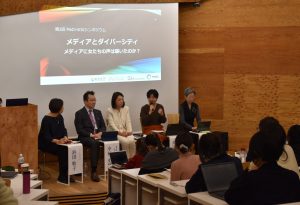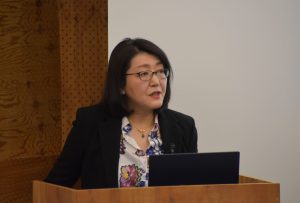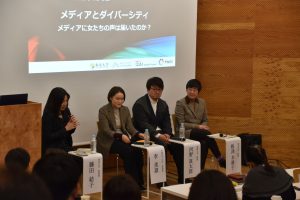2024.Jan.24
REPORTSReport on the 2nd MeDi-B’AI Symposium
“Media and Diversity: Have Women’s Voices Reached the Media?”
Yue Arima (Writer)
・Date: November 25, 2023 (Saturday), 12:00~15:10 (JST)
・Venue: Daiwa House Ishibashi Nobuo Memorial Hall, 3F, Daiwa Ubiquitous Computing Research Building, Hongo Campus, University of Tokyo
・Language: Japanese
・Organizer: Media and Diversity Forum (MeDi)
・Co-organizer: B’AI Global Forum, Institute for AI and Beyond at the University of Tokyo
(Click here for details on the event)

On November 25, 2023, the second MeDi-B’AI Symposium, titled “Media and Diversity: Have Women’s Voices Reached the Media?” took place at the Daiwa House Ishibashi Nobuo Memorial Hall on the 3rd floor of the Daiwa Ubiquitous Computing Research Building at the University of Tokyo’s Hongo Campus.
The aim of this symposium was to review the six years of activities of the Media and Diversity Forum (MeDi) and reassess its achievements and challenges. In the first part, “Is Progress Being Made in Closing the Gender Gap in the Media?” discussions focused on traditional media such as television and newspapers. In the second part, “How Does Gender Become an Issue in Digital Media?” the focus shifted to new technologies, exploring challenges related to gender.
Part 1 “Is Progress Being Made in Closing the Gender Gap in the Media?”
Moderator: Keiko Hamada (Journalist; MeDi Member)
Guest Speakers:
・Hanako Kishida (Chairperson, Japan Federation of Commercial Broadcast Workers’ Unions; Executive committee member, Fuji Television Workers’ Union)
・Yayoi Nakatani (Board Director, TBS Television)
・Shiro Nakamura (President and CEO, The Asahi Shimbun Company)
・Kaori Hayashi (Executive Vice President, The University of Tokyo; MeDi Member)
Report: Touko Shirakawa (Project Professor, Sagami Women’s University; MeDi Member)
_ “Current Status and Efforts in Domestic and International Media”
In the first part, discussions centered around the current status and challenges of closing the gender gap in traditional media such as television and newspapers.
At the beginning, Kaori Hayashi, Executive Vice President of the University of Tokyo, emphasized the importance of addressing the gender gap in the media. Achieving gender equality in media companies not only eliminates biases in sensitivity and ideation during content creation but also ensures transparency in organizational decision-making processes. It also contributes to creating a secure and safe working environment where professionalism can be fully demonstrated. Furthermore, in Japan, where women’s social participation is not progressing sufficiently, this issue is directly tied to the significant challenge of realizing authentic democracy.
To what extent has gender equality actually been achieved in media companies? What challenges do those in the workforce face? These questions were explored by examining domestic and international cases to identify approaches for addressing the challenges.
The Endeavors to Close the Gender Gap by the Asahi Shimbun Company and TBS Television
 Firstly, Shiro Nakamura, President and CEO of Asahi Shimbun Company, and Yayoi Nakatani, Board Director of TBS Television, delivered reports on the efforts and challenges within their respective companies.
Firstly, Shiro Nakamura, President and CEO of Asahi Shimbun Company, and Yayoi Nakatani, Board Director of TBS Television, delivered reports on the efforts and challenges within their respective companies.
The Asahi Shimbun Company publicly announced the “Gender Equality Declaration” in April 2020, aiming to achieve gender equality through its reporting and business operations, as well as among the ranks of its employees, who are responsible for those operations. Every May, it discloses the degree of achievement of its goals in the newspaper. Moreover, in October 2022, it proclaimed the “Gender Equality Declaration+” given the stagnation in the percentage of women in decision-making positions. This included setting new numerical goals for fostering female leaders and planning specific action plans to achieve these goals.
As of 2023, approximately half of the individuals featured in the morning edition’s “Hito (Person)” section and speakers at the Asahi World Forum are women. Also, the percentage of male employees taking parental leave increased from 12.1% in 2020 to 71.1% in 2022. However, the ratio of women in management positions has struggled to grow, remaining at 13.5% in 2022, compared to 13.3% in 2020.
Nakamura stated, “The efforts of Asahi Shimbun Company to address gender gap issues are relatively advanced within the newspaper industry; however, the newspaper industry itself is a field that is considerably lagging behind within Japanese society. The achievement rate towards the ideal is still at the foothills of the mountain.”
At TBS Television, on the other hand, efforts to eliminate gender gaps in the workplace include providing paid pre- and post-natal leave, which is generally considered unpaid leave, as well as extending the duration of the leave beyond statutory limits. They have also implemented measures such as the establishment of an in-house daycare center, a job-return system, and encouragement of taking paternal leave. Actively involving female employees in leadership training for bureau director candidates, TBS Television is consciously focused on fostering female leaders.
 As of April 2023, the overall representation of women among employees is 23.9%, while the proportion of women among new hires in April 2024 is 56%. The company aims for a 20% target for the representation of women in managerial positions, such as producers and bureau directors, a goal set for the next decade. As of August 2023, they have achieved 15.7%. However, the reality remains that there have been only two female executives throughout the company’s history, indicating slow progress in appointing women to such positions.
As of April 2023, the overall representation of women among employees is 23.9%, while the proportion of women among new hires in April 2024 is 56%. The company aims for a 20% target for the representation of women in managerial positions, such as producers and bureau directors, a goal set for the next decade. As of August 2023, they have achieved 15.7%. However, the reality remains that there have been only two female executives throughout the company’s history, indicating slow progress in appointing women to such positions.
Nakatani noted, “We have achieved half of our goal, and the next challenge is to increase the proportion of female executives. To accomplish this, there are numerous challenges to address, such as finding ways to reconcile diverse working styles and corporate growth in a Japanese society where practices like golf and business dinners, for instance, still persist.”
The Challenges Faced by Employees Due to Gender Gaps
Then, what might employees think about the gender gap in media companies? Hanako Kishida, Chairperson of the Japan Federation of Commercial Broadcast Workers’ Unions, points out that gender gaps still exist, referring to a survey conducted by the federation.
According to the federation’s 2022 survey, 63.8% of commercial television stations and 72.4% of radio stations in Japan have no female executives. When considering the proportion of female executives in the entire leadership, it remains around 3%, significantly lower than the overall percentage of women among indefinite-term employees in television and radio (25.7%). Additionally, gender wage disparities persist, even in major Tokyo-based key stations, with female regular employees earning 82.1% of their male counterparts, and non-regular employees earning 68.3%.
Women working in the media industry express concerns about workplace challenges resulting from the slow progress in addressing the gender gap. They cite issues such as long working hours, inadequacies in systems related to childbirth and childcare, lack of awareness among managerial positions, as well as biases in appointments and evaluations. Particularly in regional areas, the absence of role models is evident, posing challenges to the improvement of women’s representation and working conditions.
Kishida commended the efforts of the Asahi Shimbun Company and TBS Television, stating, “Eliminating the gender gap is essential for the survival of the industry. Setting goals and developing specific plans, I hope the entire industry will undertake initiatives similar to those of these two companies.”
Insights into Resolving Gender Gaps in Media Companies through Case Studies
 In Japanese media companies, despite an increase in the proportion of women in the workforce, the representation of women in decision-making positions remains a challenge. Touko Shirakawa, Project Professor at Sagami Women’s University, delivered reports on how overseas media companies have overcome similar challenges.
In Japanese media companies, despite an increase in the proportion of women in the workforce, the representation of women in decision-making positions remains a challenge. Touko Shirakawa, Project Professor at Sagami Women’s University, delivered reports on how overseas media companies have overcome similar challenges.
In the wake of movements such as #MeToo, the COVID-19 pandemic, and the Black Lives Matter movement, there has been a growing trend among American media companies to approach diversity – encompassing gender, race, disability, and social hierarchy – as a strategic component of their management. Numerous companies have established numerical goals to enrich the diversity of their organizational structure, personnel decisions, and the individuals featured in their content. They regularly disclose their achievements in this regard. Keith Woods, the Chief Diversity Officer at National Public Radio (NPR), underscores the media’s role in conveying diverse perspectives beyond existing disparities and presenting relatable personas for a diverse audience.
Indeed, it is not uncommon in Western countries for the proportion of women in managerial positions to exceed 40%. The background to this lies in a different perspective on work styles compared to Japan. In a talk event featuring Keiko Yamamoto of NHK, the editor-in-chief of Iceland’s state broadcaster, and a former editor-in-chief of a Finnish newspaper, Yamamoto expressed, “Because the media is required 24/7, it becomes challenging to balance with life events.” Responding to that comment, the other two participants noted, “The issue of being forced to choose between work and family may stem from workplace structures,” and “There are differences in labor culture between Japan and the Nordic countries.”
Nakamura suggests that behind the stagnation in the proportion of women in managerial positions lies a fundamental issue with the working style of management, such as “working long hours” and “sacrificing family for work.” In response, Shirakawa introduced examples from Nordic countries where night shifts are handled by individuals from the generation that has completed child-rearing, and in France, there are voices advocating not appointing workaholics to managerial positions, which prompted a significant reaction from the audience.
Furthermore, journalist Keiko Hamada, who has covered diversity in general businesses, said that a crucial aspect is the mindset reform of men in middle-management positions. For instance, in an experiment conducted by Recruit, where they reevaluated the requirements for managerial positions that had contributed to the stagnation in the increase of female managers, the number of female managers in the relevant department doubled, and candidates included a different type of male employee than before.
Lastly, Hayashi mentioned that in the United States, among the prestigious Ivy League universities, six out of eight have female presidents, highlighting that examples where female leaders act as game-changers are not uncommon. She concluded by expressing the hope that media companies, for the sake of industry survival and leading democratic societies, would convey the message that the power of women is essential.
Part 2 “How Does Gender Become an Issue in Digital Media?”
Moderator: Yuiko Fujita (Associate Professor, Interfaculty Initiative in Information Studies, The University of Tokyo; MeDi Member)
Guest Speakers:
・Yuko Itatsu (Professor, Interfaculty Initiative in Information Studies, The University of Tokyo; Director, B’AI Global Forum)
・Misook Lee (Associate Professor, Department of Communication and Culture, Faculty of Humanities, Otsuma Women’s University; MeDi Member)
・Shintaro Kono (Professor, School of international communication, Senshu University)

The second part focused on the representation of gender in digital media by exploring gender portrayals in the digital domain, as well as examining the unfolding dynamics of feminism and misogyny in digital spaces.
Gender Discrimination and Sexual Violence in Media Culture
Firstly, Professor Misook Lee of Otsuma Women’s University presented on gender discrimination and sexual violence in media culture.
From station posters to advertisements on websites and video-sharing platforms, Japan is inundated with depictions of women portrayed in a sexualized manner. Recent instances, such as “Aoshima Megu,” the mascot of Shima City in Mie Prefecture, which sparked controversy on social media, and Suntory’s beer advertising video for “Itadaki,” highlight this trend. Moreover, in the field of AI technology, applications that generate various avatars based on facial photos have led to situations where men are portrayed as pilots or lawyers, while women are subjected to more sexual descriptions.
Portraying women as sexual objects, in other words, sexual objectification, has long been considered harmful as it reduces women in society from individuals with personalities to objects and compels the perception of them as mere “things” or “tools.” This detrimental aspect has persisted from traditional media to digital platforms and even within AI technologies.
Living in an environment filled with images of women being sexually objectified may result in a loss of the sense of treating women as equal beings, leading to an internalized, insensitive perspective toward women’s thoughts and feelings. Lee cautioned that this, in turn, could contribute to a distorted perception of women, causing society to become desensitized to sexual victimization of women, reinforcing rape myths, and promoting the justification of violence.
Digital Media and Popular Misogyny
Next, Professor Shintaro Kono of Senshu University presented on misogyny in the recent media environment.
Sarah Banet-Weiser, a researcher in gender/feminism and media studies, refers to the visibility of feminism on the internet and platforms as “popular feminism” and the reactionary response as “popular misogyny.”
 “Popular misogyny” refers to the emotions where individuals feel “hurt” by the discourse presented by “popular feminism,” perceiving that they have been wounded and their “capabilities” restricted. Its characteristic lies in being amplified through the media. A typical example is the emergence of “incels” (involuntary celibates) in the United States on the internet since the 2000s, who harbor resentment, blaming feminism and feminists for their perceived lack of romantic success.
“Popular misogyny” refers to the emotions where individuals feel “hurt” by the discourse presented by “popular feminism,” perceiving that they have been wounded and their “capabilities” restricted. Its characteristic lies in being amplified through the media. A typical example is the emergence of “incels” (involuntary celibates) in the United States on the internet since the 2000s, who harbor resentment, blaming feminism and feminists for their perceived lack of romantic success.
While Banet-Weiser’s theory is based on the American media environment, Kono points out that a similar phenomenon is occurring in Japan, particularly in relation to popular misogyny. He highlighted the notable example of the Open Letter case in 2021 and explained the mechanism through which social media and traditional media mutually engage, fostering misogyny.
Media Representations of Female Robots
Lastly, Professor Yuko Itatsu of the University of Tokyo presented on the media representation of female robots.
Social robots encompass those that engage with humans, including the dog-like pet robot “aibo,” the seal-like caregiving and pet robot “Paro,” and chatbots featured on websites and digital signage. Although the tasks delegated to robots are gender-neutral by nature, certain social robots are deliberately assigned gender labels such as “female” or “male.”
In such cases, projecting biased gender views onto robots can potentially lead to tangible harm. According to a 2022 survey conducted in India, approximately 70% of both men and women responded that “the appearance of AI robots, including factors like race and skin color, influences purchasing decisions,” and about 60% indicated that “representing AI robots as female contributes to sales promotion.” Concerningly, around 50% of men and 60% of women expressed worries that “imparting female traits to AI robots could contribute to the reinforcement of biases.”
The gender representation of robots may widen gender disparities in society. Female robots, portrayed as intelligent entities with specialized functions, exist in non-Western countries, such as “Omeife” in Africa, fluent in eight languages and skilled in cross-cultural negotiations, and “Shalu,” a teacher robot in India proficient in nine Indian and 38 foreign languages. Itatsu pointed out that these female robots could provide insights into how the gender representation in AI robots should evolve in the future.
After the presentations by the three guest speakers, a lively discussion ensued on topics such as femininity and substitutability in social robots, the role of traditional media in preventing the promotion of popular misogyny, and issues related to freedom of expression and human rights. It was confirmed that gender equality and awareness of human rights are crucial in the realm of new media.
Media Representation in the New Era and Challenges for MeDi
Established in 2017, MeDi has provided a platform for media professionals, researchers, and other experts to collectively examine media representation as well as issues of sexual harm and gender gaps in the media. Over the past six years, its impact has invisibly yet steadily materialized, primarily within traditional media.
However, as confirmed in the second part of the symposium, societal and cultural dynamics, along with their influences, have also permeated into new technologies. MeDi must continue its efforts to create a space for contemplating media representation, ensuring that existing disparities and power imbalances are not perpetuated in the media and expressions of this new era.

Report: “A Review of MeDi Activities and Future Challenges”
Keiko Kojima (Essayist; MeDi Member)
Renge Jibu (Associate Professor, Institute of Liberal Arts, Tokyo Institute of Technology; MeDi Member)

Closing Remarks
Tohko Tanaka (Professor, Interfaculty Initiative in Information Studies, The University of Tokyo; MeDi Member)